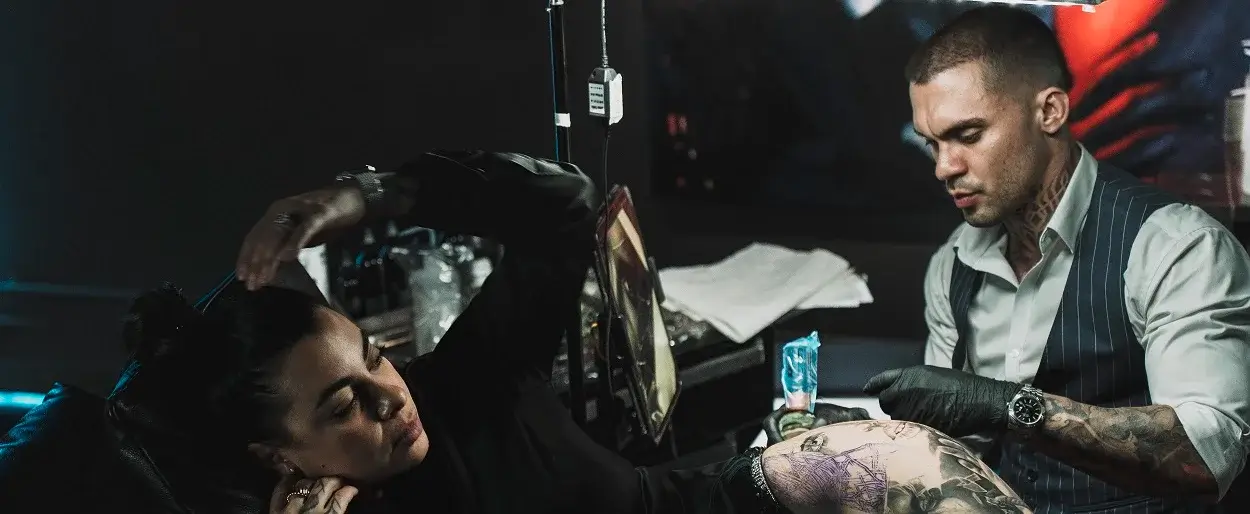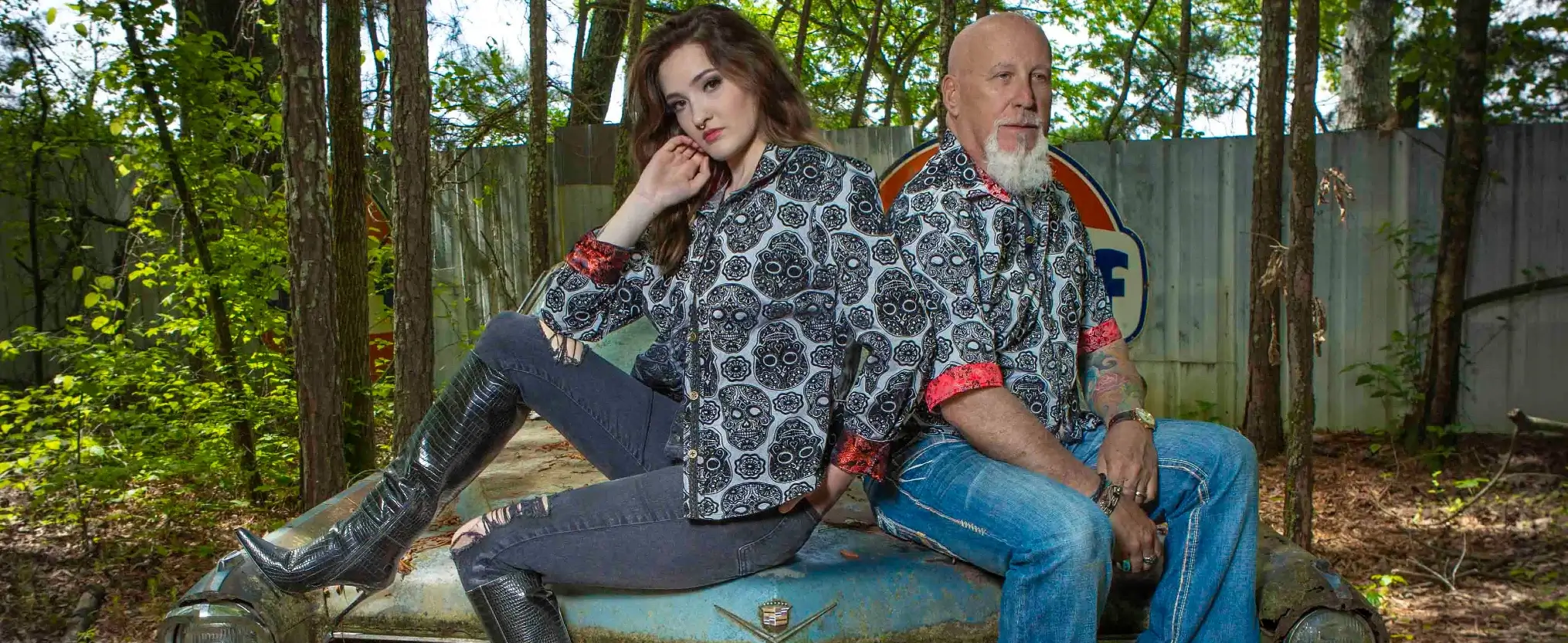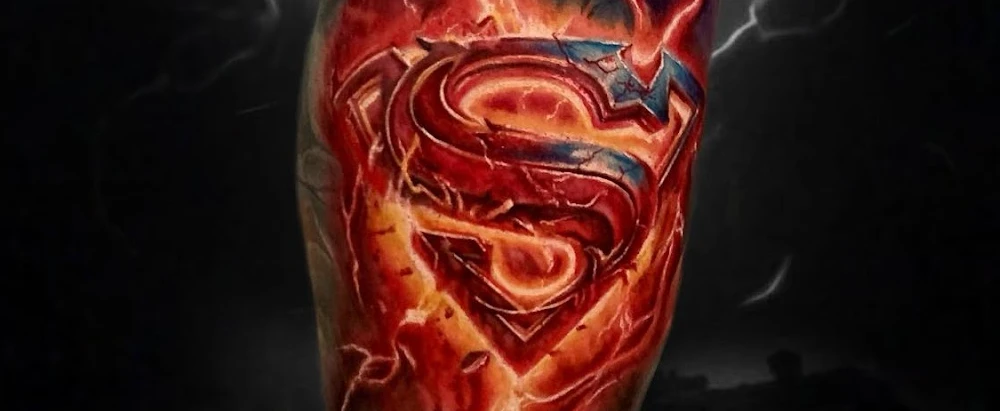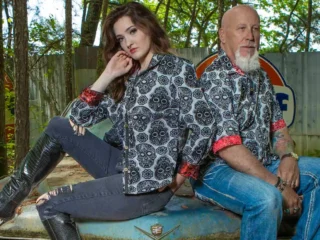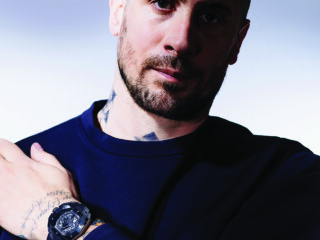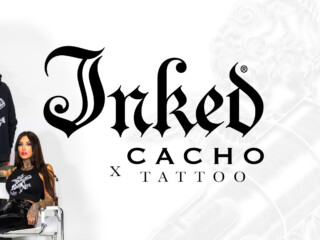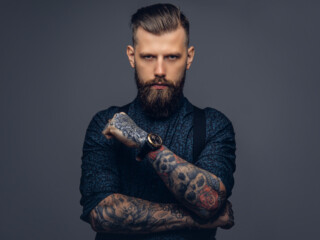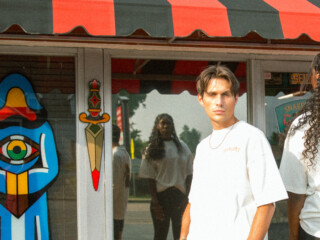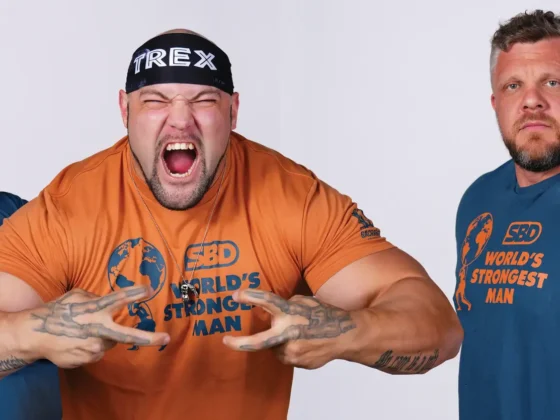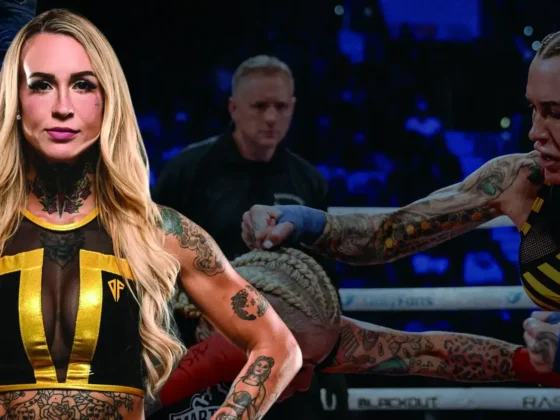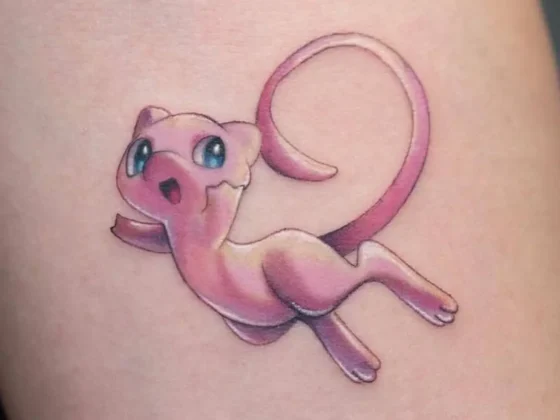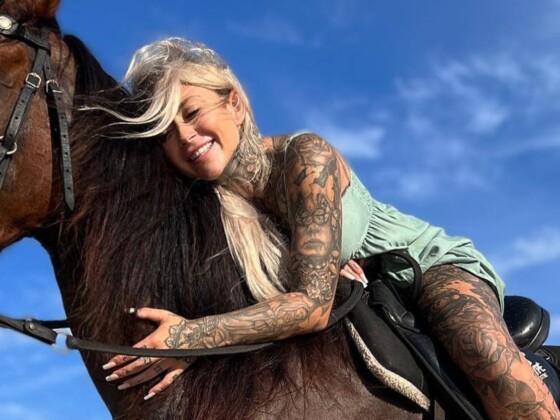Inked Mag Staff
December 30th, 2015
Jes Baker Q&A: ‘My Tattoos Were About Becoming Visible’
The unapologetic, outspoken self-love author Jes Baker started getting tattooed almost a decade ago, when she was 20-years-old, on the places she hated most on her body. This ink came…

The unapologetic, outspoken self-love author Jes Baker started getting tattooed almost a decade ago, when she was 20-years-old, on the places she hated most on her body. This ink came long before she was confident and proud to identify as a “fat woman,” but in time the tattoos helped her to show off and love her body. “I got this giant shoulder piece,” Baker told Inked. “It took away my excuse of not showing my arms because I loved it.”
Baker realized she was a heavily tattooed person when her chest piece was complete, which only added to the stares she receives from bystanders as she refuses to conform to society’s idea of how overweight girls should dress. “I wear unapologetically tight clothing that throws people off because I am not trying to hide,” she said. “My tattoos are most certainly one of the ways that I demand to be seen.”
Before making a career out of body positivity, the 28-year-old mental health professional said, “I was in complete denial about my body, I just knew that I hated it.” Her bold and successful blog, The Militant Baker, gained attention when she released her Attractive & Fat photos in 2013, slamming Abercrombie & Fitch for their fat-free ideals.
Approaching 2016, Baker wraps up a book tour for her first book Things No One Will Tell Fat Girls: A Handbook For Unapologetic Living. Baker said the book encourages readers to question everything. “Everything that you’ve learned about your body is bullshit,” she said. “The diet industry is not a charity. It’s here to make 60 billion dollars a year to help you not feel good.”
To start the new year with a kickass mindset, read our Q&A with Baker to find out why we need to take more #selfies, how altering your social media feed will change your life for the better and why she chose a Kitchen Aid tattoo over a Kitchen Aid mixer.
What’s the biggest bullshit the media feeds women?
We’re getting a lot of mixed messages. We’re hearing things like, “Hide your flaws but love yourself.” So, hide the parts that are bad but still love yourself. Or we’re hearing, “Have confidence, but don’t be too confident because then you’re an attention whore, you take too many selfies. Empower yourself but don’t take up too much space.”
It’s silly to not believe that our bodies and our minds are connected. The way our body reacts to the world, whether it gains weight or loses weight or ages faster or ages slower, all of these different things are very connected to our brain.
We don’t ever focus on that. Ever. It’s the last thing we look at. From working in mental health, I see that as the number one thing. Take care of your brain and everything else will follow.
We’re always working from the outside in. We have it totally backwards.
We do when it comes to long-term change. A lot of people work from the outside in and it works for them for a short amount of time, but if we’re looking for lasting change we have to do it the other way around.
How do you start loving yourself?
The most important thing is to acknowledge that we’re going to need some help. We are so brainwashed and we need to have back-up support. The hard part is finding people in real life that support this, that think the same way, that don’t talk shit about each other’s body—people who don’t make harmful food comments at dinner. Try to find a community.
There is a giant body-positive community online. Tumblr changed my life. If we don’t consciously alter our social media feeds, we will be seeing the same images over and over again, which is really harmful even though we don’t recognize that it is. So I found all of these diverse, inclusive, body-positive tumblrs on accident one day and followed all of them. I was fascinated and kind of horrified by what I was seeing. I scrolled through them everyday and it reconditioned my brain.
It’s trending online and that’s good—some of it is watered down, some of it is not helpful, but there is a lot of good stuff out there and a lot of good people. If you surround yourself at least digitally, you’ll start to see the transformation at least a little bit. Hopefully that affects your in-real-life situation, too.
Your feed has so much to do with how you feel mentally and physically.
In the beginning it is really hard to challenge those thoughts and think, Okay this isn’t real, this is something completely different that doesn’t apply to me. I just encourage people to do a very quick, brainless deleting of stuff that’s harmful, and filling with things that are wonderful, and then just letting it take care of itself for a while.
There was a study that found a woman’s confidence peaks at age 9.
Well there’s a statistic that says 40 percent of fourth and fifth graders are dieting right now to change their body before they’ve even developed. They’re not exercising. They’re dieting.
That is extreme for so many reasons; they are so impressionable. But they’re on their Instagram feed and they’re seeing all of these images. How do we change that?
There are a lot of controversial opinions around selfies and Likes and how girls count the Likes. I think the way to combat that is to teach authentic representation of you.
Part of my book is about how taking selfies is really good for you. It’s not something you should shy away from; in fact, you should do it more. The difference is that you do it authentically. You don’t alter; you don’t change. If you want to take “the most flattering” pictures of yourself because that’s how you feel comfortable, that’s fine, it’s all you. But eventually, using selfies to tell stories, to reclaim your own narrative, to be authentically you.

That’s a lot easier said than done.
Sometimes I post the one I like the most, but of course I’m trained to think that’s the most flattering. Sometimes I pick the ones that are not that at all, in fact I do that often because it is good for people to see that shit. It’s good for me to see that.
Let’s talk about your tattoos. How many do you have?
I think I have about 20. But they’re all meshed together at this point. I started getting them when I was 20. My first one was a rebellious act. I live in Tucson, Arizona, so it is very tattoo-culture here, downtown. I think we have as many tattoo parlors as we do cafés and bars.
A lot of people say tattoos help them to feel comfortable in their own skin. Was that the case for you?
You’re totally right. For a lot of people it’s about reclaiming their body. But this was long before I had any concept of body positivity.
I started to get tattooed on the places I hated on my body. Arms were a really big deal. I got this giant shoulder piece and then I wanted to wear sleeveless shirts so people could see it because I loved it. It kind of took away my excuse of not showing my arms.
I started getting tattooed on the underside of my arms which was really scary and then I got tattooed on my side, like belly side, so that was really interesting.
What is that tattoo?
That tattoo is a poem by Sandra Cisneros, she wrote The House On Mango Street. She also wrote this amazing book of feminist poetry from Mexico, so it’s a couple of lines from that. It’s kind of my reclaiming power feminist tattoo and I love it.
I’ve gained weight since I was 22, 23, and so it is a little stretched which makes it even harder and even more important to love.
Do you recognize a lot of your tattoos as efforts to love yourself?
I think that for me tattoos were about becoming visible. I don’t think I knew this back then, but I know now. My tattoos are most certainly one of the ways that I demand to be seen. So as a fat woman, to walk confidently, really throws people off. If you walk around like you don’t give a fuck, it’s just the way you carry yourself that throws people off.
I wear unapologetically tight clothing that also throws people off because I am not trying to hide, and then I’m covered in tattoos. It is basically this very visual way of taking up space and not apologizing for it.
I didn’t know my tattoos would become that but they are very much a large part of me reclaiming my space as a human.
Tattoos are always attracting attention, good or bad.
Yes. And I do live in Tucson so I blend in here and it’s a smaller town so people know me. But I drive two hours to Phoenix, which is more of an industrial city, and you would think I was a circus pony. It’s like going to another country, they’re definitely still very visible and not accepted and that’s okay. I enjoy it. I love pushing people’s buttons.
If you could give advice to your younger self, what would you say?
To my younger self is a really good way to look at it. I would ask my younger self to find an adult that I really admired. And I actually can think of one when I was probably 12 or 13. Her name was Gail and she broke all the boundaries. She did not subscribe to her traditional femininity—and this was at church, which was very rare—I was Mormon so that was very strange. She was my inspiration and I held on to that for a very long time.
If they have someone that they feel comfortable with and inspired by, it’s really good to have a relationship with that person.
I think a lot of times we pick up our parents’ ideologies about our bodies. They’re not correct in saying whatever it is about them or you.
I’d also tell myself, You just need to get through this. It’s going to be a really difficult time to love yourself for the next 10 years, but you’re going to fucking make it and then you’re going to have more control over your life and it’s going to be just fine.
Tell us which of your tattoos are most important to you.
I have a tattoo [inspired by] Alphonse Mucha, who is a zodiac artist, on my left shoulder. It’s the first really big one I got. Go big or go home! On the inside of my left arm I have CTR and that stands for Choose The Right, which is a saying from the Mormon church; I grew up as a Mormon for 20 plus years.
But you said you’re not religious now?
No. My chest piece is one of my favorites. It’s from this book of really badass women from the ‘60s with the beehives and winged eyeliner. It’s a newer but very similar version and that was kind of the moment where I was like, “Alright I’m a heavily tattooed, visibly tattooed person now. There is no hiding this!”
On my right shoulder I have a giant Kitchen Aid mixer for baking. I literally could have purchased a Kitchen Aid or gotten the tattoo and I was like, tattoos last longer!
Do different artists do your tattoos?
Kristin Young did the mixer; she’s here in Tucson still. And then my chest piece is by Amy Shapiro. She works in Brooklyn now.
What do some of your other tattoos mean?
Two of them are mental health tattoos. I have a giant tattoo of a brain, which doesn’t sound very sexy but it’s awesome and it has hydrangeas around it. It’s on my right arm underneath the Kitchen Aid and it has a banner and that says, “Best friend, worst enemy.” That is kind of my homage to mental health, which is my life story.

Can you explain that?
My brain does incredible things; it also tries to fuck me over regularly. My favorite tattoos that I have are the ones right above my knee. It says, “My life my rules.” Kristin did those and they are by far my favorite.
The last ones are on the top of my feet, where people would normally get stars or something but they’re pills that I take for my mental illnesses and so they’re like in Sailor Jerry fashion; they’re these amazing traditional capsules and pills on my feet which people are like, “What the fuck are those?” I tell them and they freak out because I’m so open about taking Prozac and it’s good for them.
Do you mind if I ask about your mental health?
No, not at all! I talk about it all the time. I have been diagnosed with chronic depression and then also borderline personality disorder, which is a very complicated diagnosis because it is something that you can unlearn. But I think the things around borderline personality disorder that make it difficult can resurface in crisis, so I am just constantly taking care of myself so that it doesn’t resurface.
Do you think that accepting your body and who you are has helped to let go of the borderline personality disorder?
It’s very complicated to talk about, but some of them stem from feeling not good enough. A lot of problems come from growing up in a really invalidating environment, so you’re constantly trying to survive in a world where you feel like you’re not good enough. To a certain extent we all deal with that issue.
There is this thing called DBT, Dialectical Behavior Therapy, it’s for people who have borderline personality disorder. I feel like every human in the entire world should take the course in therapy because it’s all about coping in a really healthy way in a fucked up world.
Anyways, I feel like there is a lot of stigma in borderline personality disorder when in reality we all have little shades of the same fears and inadequacy.
So yes, learning to love myself, accepting that I’m enough, being okay, having support helps. In mental health, talking about the hard stuff, being vulnerable and finding community with those who have the same experience is how you make it through and it’s the same thing with body image.
You have to be open, you have to be honest, you have to work through the hard stuff, and you have to find people who have been there too. And we all have, so it’s easy to do, but our first instinct is to hide and be okay when we’re really not.
Everyone is insecure about something.
The thing that I laugh about is ya know even Kim Kardashian has cellulite, something that we’re told we’re not supposed to have. Ninety percent of women have it; they’re just not talking about it. Perfection doesn’t exist.
To find out more about Jes Baker, visit her blog @ themilitantbaker.com and check out the photo gallery below.
Editor's Picks
Bridging Classical Art and Modern Tattooing
Esteban Rodriguez brings the discipline of classical fine art to the living canvas of skin, creating hyper-realistic tattoos that merge technical mastery with emotional depth.
Show Your Ink Fashions Brings Custom Style to Tattoo Culture
Show Your Ink Fashions creates custom shirts designed to showcase your tattoos as wearable art, blending fashion with personal expression.
The Ultimate “Superman” Tattoo Roundup: Just in Time for Superman’s Return to Screens
With Superman’s big return to theaters, fans are revisiting some of the most iconic ink inspired by the Man of Steel.


